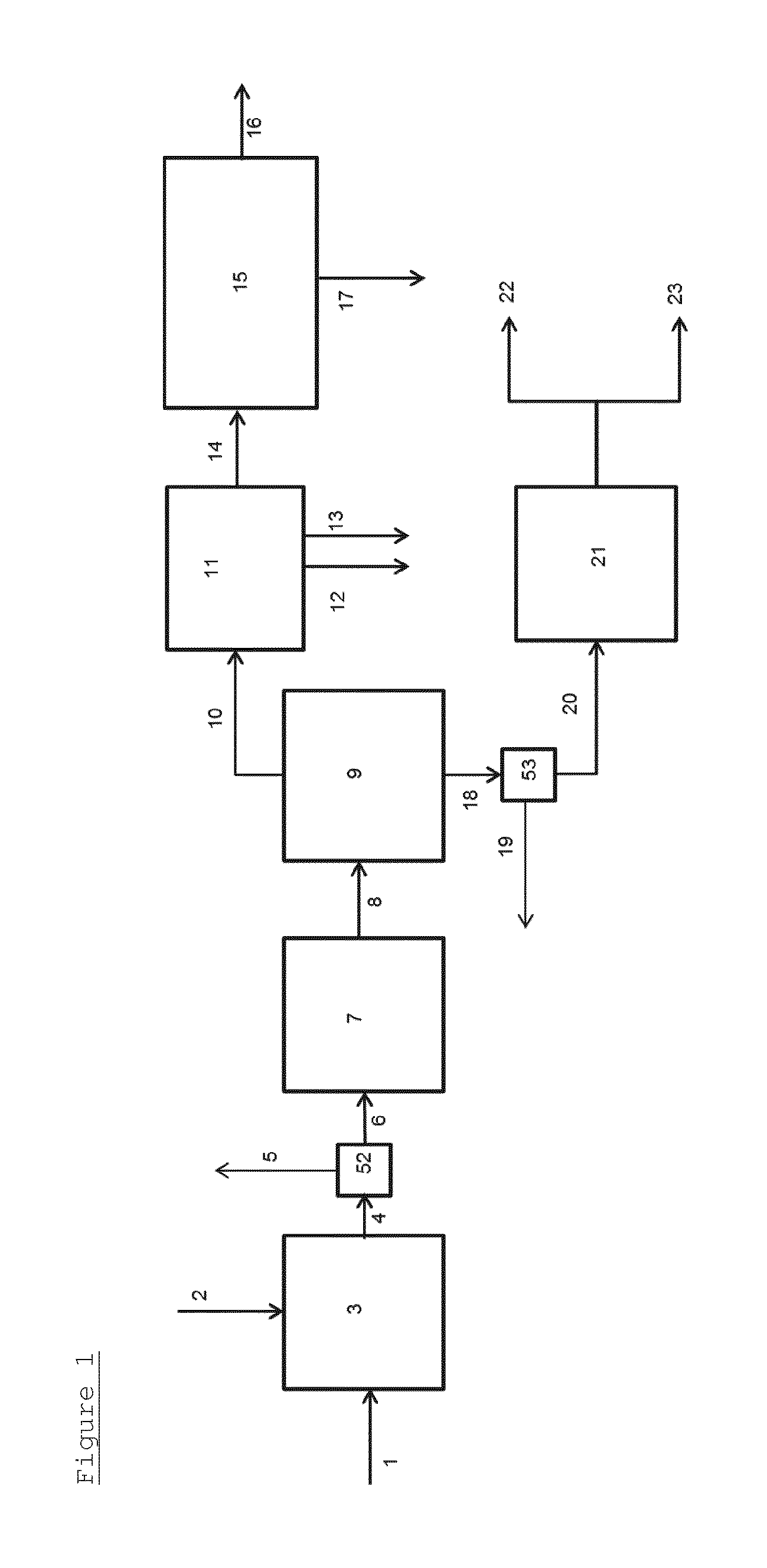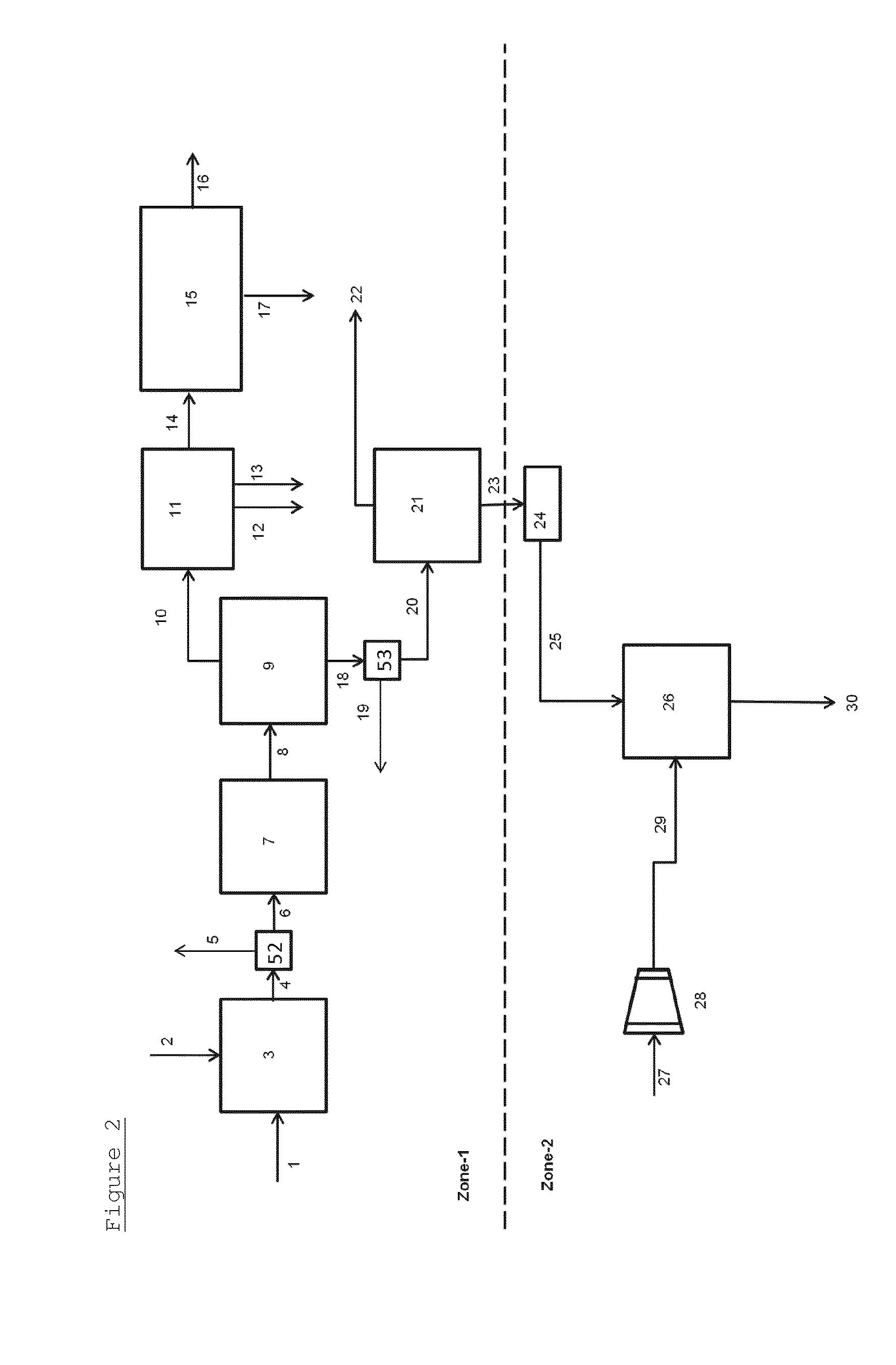Conversion of biomass or residual waste material to biofuels
- Summary
- Abstract
- Description
- Claims
- Application Information
AI Technical Summary
Benefits of technology
Problems solved by technology
Method used
Image
Examples
example 2
Of the Invention
[0098]This Example was carried out according to the process illustrated in FIG. 2.
[0099]The fractionated combined middle distillate product of Example-1, having a total aromatic content of approximately 83 wt % (measured in accordance with IP-391 method) and a density of 0.9251 g / mL at 15° C., was used as feed to reactor 26 in FIG. 2. The catalyst used was a bulk nickel catalyst, commercially available from CRI Catalyst Co under the trade name KL-6515. The nickel on the catalyst was reduced to metallic form before the introduction of the feed.
[0100]The feed was processed over KL-6515 at a temperature of 240° C. and a pressure of 25 barg. The hydrogen to feed ratio was 1064 N1 H2 / kg feed, and the WHSV was 1.05 kg feed per kg catalyst per hour.
[0101]As seen from Table 3, under the operating conditions of 240° C. and 25 barg, 65% of the aromatics are hydrogenated by this catalyst and density is reduced by >0.05 g / mL. The resulting product undergoes ignition in a compres...
example 3
Of the Invention
[0102]This Example was carried out according to the process illustrated in FIG. 2.
[0103]The fractionated combined middle distillate product of Example-1, having a total aromatic content of approximately 83 wt % (measured in accordance with IP-391 method) and a density of 0.9251 g / mL at 15° C., was used as feed to reactor 26 in Table 4.
[0104]The catalyst used was a bulk nickel catalyst, commercially available from CRI Catalyst Co under the trade name KL-6516. The nickel on the catalyst was reduced to metallic form before the introduction of the feed.
[0105]The feed was processed over KL-6516 at a temperature of 300° C. and a pressure of 50 barg. The hydrogen to feed ratio was 1032 N1 H2 / kg feed, and the WHSV was 0.96 kg feed per kg catalyst per hour.
[0106]As seen from Table 4, under the operating conditions of 300° C. and 50 barg, 70% of the aromatics are hydrogenated by this catalyst and density is reduced by 0.0575 g / mL. The resulting product undergoes ignition in a ...
example 4
Of the Invention
[0107]A fractionated middle distillate fraction of the hydroconversion reactor product, having a total aromatic content of approximately 83.1 wt % (as measured using IP-391) and a density of 0.9265 g / mL at 15° C., was used as feed to a hydrodesulfurization reactor. The catalyst used for the hydrodesulfurization step was a sulfided CoMo catalyst supported on an alumina support (commercially available from CRI Catalyst Co as S-4223). The hydrodesulfurization step was carried out at a liquid hourly space velocity of 1 lit feed / lit cat·hr, a pressure of 32 barg, gas-to-oil ratio of 250 normal liter of hydrogen / kg feed, and a temperature of 330° C. The sulfur content of the feed was 12 ppmw before hydrodesulfurization, and nitrogen content was 148 ppmw. After hydrodesulfurization, the product was analyzed to contain about 4 ppmw sulfur and about 1 ppmw nitrogen. There was a marginal density reduction after hydrodesulfurization from 0.9265 g / mL to 0.9220 g / mL, and no signi...
PUM
 Login to View More
Login to View More Abstract
Description
Claims
Application Information
 Login to View More
Login to View More - R&D
- Intellectual Property
- Life Sciences
- Materials
- Tech Scout
- Unparalleled Data Quality
- Higher Quality Content
- 60% Fewer Hallucinations
Browse by: Latest US Patents, China's latest patents, Technical Efficacy Thesaurus, Application Domain, Technology Topic, Popular Technical Reports.
© 2025 PatSnap. All rights reserved.Legal|Privacy policy|Modern Slavery Act Transparency Statement|Sitemap|About US| Contact US: help@patsnap.com



